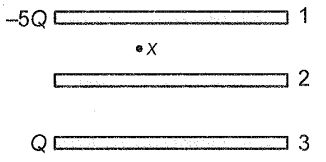Electric field at an axial point of short dipole is . If the electric field at the equatorial point of same dipole is , then which of the following is correct?
1. . < 0
2. . > 0
3. . = 0
4. . =
A long thin rod is charged such that charge per unit length of the rod is . The rod is inserted into a hollow spherical surface of radius R. Maximum electric flux coming out the surface is
1.
2.
3.
4.
Two charges q and 4q are separated by a distance r. The neutral point(in between the line joining the charges) is at a distance:
1.
2.
3.
4.
A positron and a proton are projected normally into a uniform electric field with equal kinetic energy. The trajectory followed by them are:
| 1. | Circular with equal radius |
| 2. | Elliptical with the same major and minor axis |
| 3. | Parabolic with the identical trajectory |
| 4. | Hyperbolic with the identical trajectory |
The distance between two point charges is increased by 10%. The force of interaction
1. Increases by 10%
2. Decreases by 10%
3. Decreases by 17%
4. Increases by 17%
Cm is the SI unit of
1. Electric flux
2. Electric potential
3. Electric dipole moment
4. Electric field intensity
A solid sphere of radius R has a uniform distribution of electric charge in its volume. At a distance x from its center (x<R), the electric field is directly proportional to
1.
2.
3. x
4.
An insulated sphere of radius R has a uniform charge density . The electric field at a distance r from the center of the sphere (r<R) is-
1.
2.
3.
4.
The electric flux from a cube of edge \(l\) is \(\phi\). What will be its value if the edge of the cube is made \(2l\) and the charge enclosed is halved?
1. \(\frac{1}{2}\phi\)
2. \(2\phi\)
3. \(4\phi\)
4. \(\phi\)
Three identical plates are kept as shown. Plate 1 is given -5Q charge and plate 3 is given Q charge. Electric field intensity at point x is

1.
2.
3.
4.






